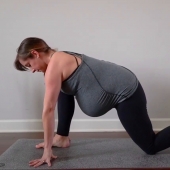Pregnancy creates considerable stress on a woman’s body. Scientific studies show, however, that for healthy pregnancies, exercise offers remarkable advantages. By engaging in physical activity during pregnancy such as toning and cardiovascular exercise, pregnant women can experience less fatigue, improved posture, decreased back pain, better sleep, improved well-being and shorter deliveries.
Biceps exercises during pregnancy: Before you know it, you'll be carrying your heavy baby in one arm and your even heavier diaper bag in the other, so it's a good idea to tone your biceps now while your belly is still doing the heavy lifting. Bicep curls during pregnancy are a great way to begin. Start by selecting light weights (three- or five-pound weights if you're a beginner, and never lift more than 12-pound weights). Stand with your legs shoulder-width apart, making sure not to lock your knees. Keep your elbows in and your chest up. Slowly raise both weights toward your shoulders, (remember to breathe), stopping when your forearms are perpendicular to the floor. Lower slowly and repeat. Try to do eight to ten repetitions, but take breaks if needed and don't overdo it. You'll feel a burn in your muscles, but you should never strain or start holding your breath.
Kegel exercises: Now here's the ultimate exercise for multitaskers. Kegels — exercises to help strengthen your pelvic floor, a muscle group that controls the flow of urine and the contraction of the vagina and anal sphincter and that can be weakened by the pressures of pregnancy and delivery — may be done any time of the day or night, no matter what else you're in the middle of doing. And there are compelling reasons to do them. First, they prevent urinary incontinence, a pretty common complaint late in pregnancy and during postpartum — as well as fecal incontinence, which while less common, can be even more uncomfortable and embarrassing. Second, they can tone your pelvic floor in preparation for labor and delivery — and possibly help you avoid an episiotomy.
Third, flexing your pelvic muscles through Kegels can improve sexual satisfaction — for both of you — postpartum (when those muscles will need some tightening up). To flex those muscles, though, you'll first need to familiarize yourself with which ones they are. No mirror (or strange contortions) necessary — all you have to do is stop the flow of urine the next time you're on the toilet. The muscles you use are the ones you'll want to tense up when doing your Kegel exercises. Try tensing and holding these muscles for as long as you can, working up to eight or ten seconds. Then slowly relax them. Keep practicing until you can do three sets of ten to 20 each day. You can also do three sets of quick Kegels daily: Count to ten (work your way up to 20), contracting and relaxing your muscles with each count. Do Kegels at your desk, on line at the supermarket, and most of all, when you're making love — the very best way to mix business with pleasure (do it and you'll see why).
Leg lifts during pregnancy: Leg lifts use your body's own weight to tone your thigh muscles (no infomercial equipment necessary). Simply lie on your left side with your shoulders, hips, and knees lined up straight. Support yourself by holding your head with your left arm and placing your right arm on the floor in front of you. Then slowly lift your right leg as high as you comfortably can (remember to breathe). Do ten reps, then switch sides and repeat.
Pelvic tilts during pregnancy: This simple routine can help improve your posture (every pregnant woman can use help with that), strengthen your abs (thus reducing back pain), and help prepare you for labor (with those stronger stomach muscles and more flexible back muscles). To do a pelvic tilt, stand with your back against a wall and relax your spine. As you inhale, press the small of your back against the wall. Exhale, then repeat several times. For a variation that also helps reduce the pain of sciatica, try rocking your pelvis back and forth — keeping your back straight — while either kneeling on all fours or standing up. Do pelvic tilts regularly (take a five-minute pelvic-tilt break several times during your workday).
Squats during pregnancy: This exercise strengthens and tones your thighs and is particularly useful for women who plan to deliver in the squatting position. To begin, stand with your feet shoulder-width apart. Keeping your back straight, bend at the knees and slowly lower yourself as close to the ground as you comfortably can, keeping your heels on the ground. If you can't, try moving your feet farther apart. Hold the squat for ten to 30 seconds, then slowly come back to a standing position. Repeat five times. (Note: While squats are fine, lunges and deep-knee bends should be avoided, as your joints will be more prone to injury.)
- 15 views













